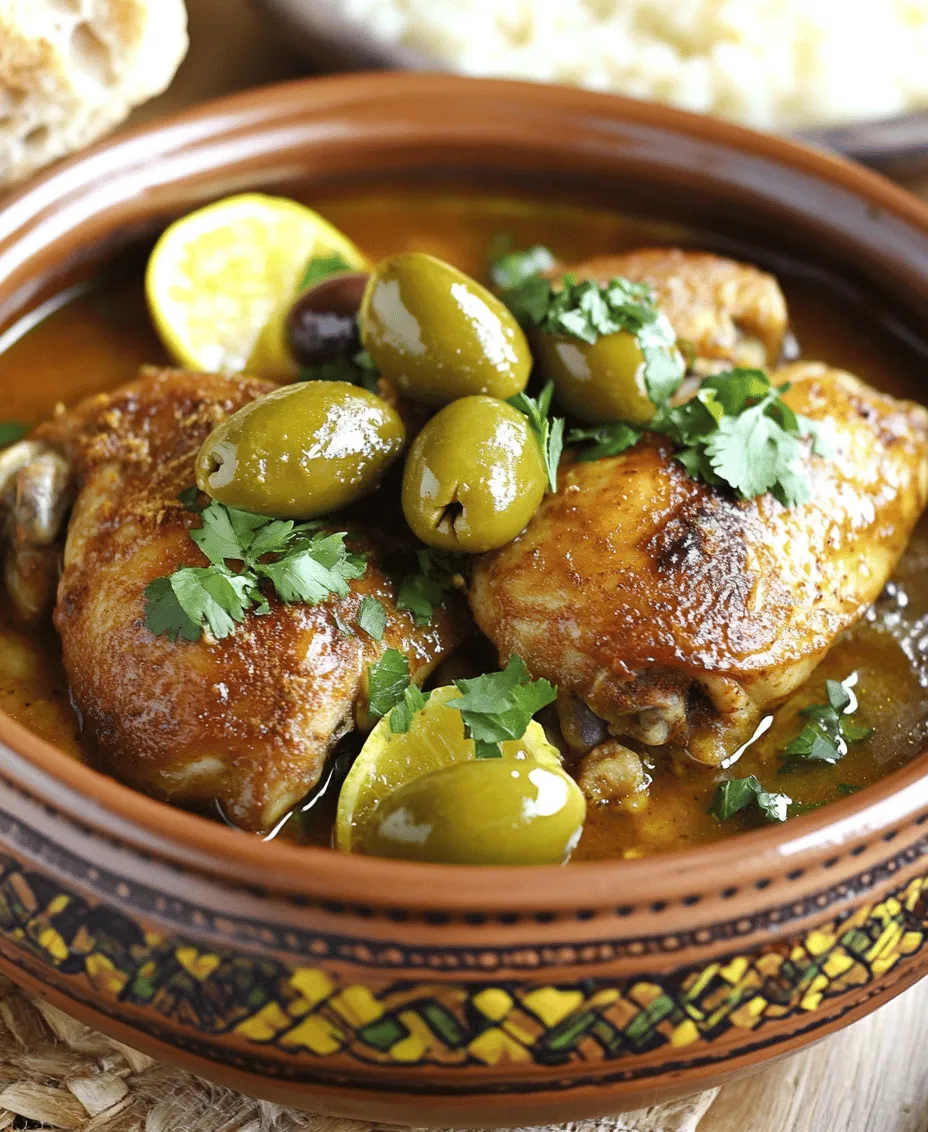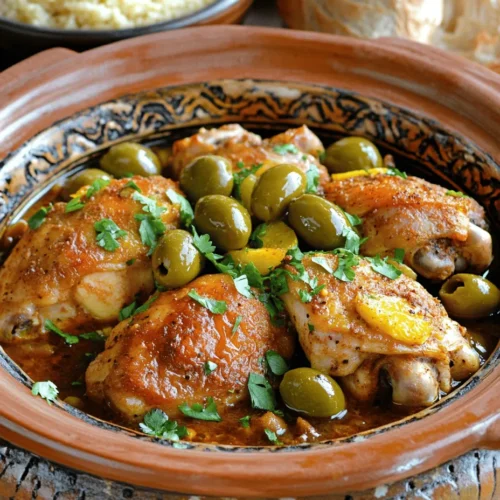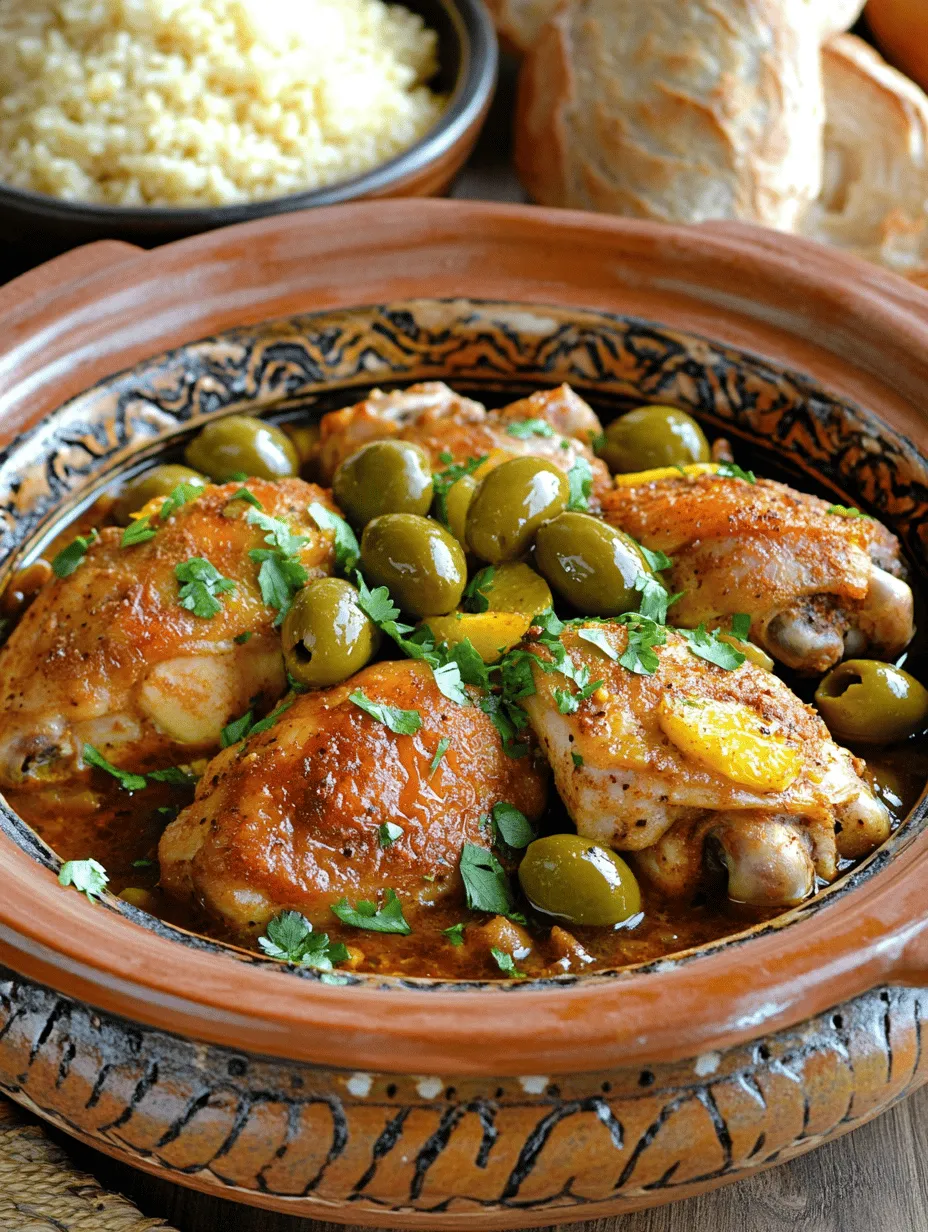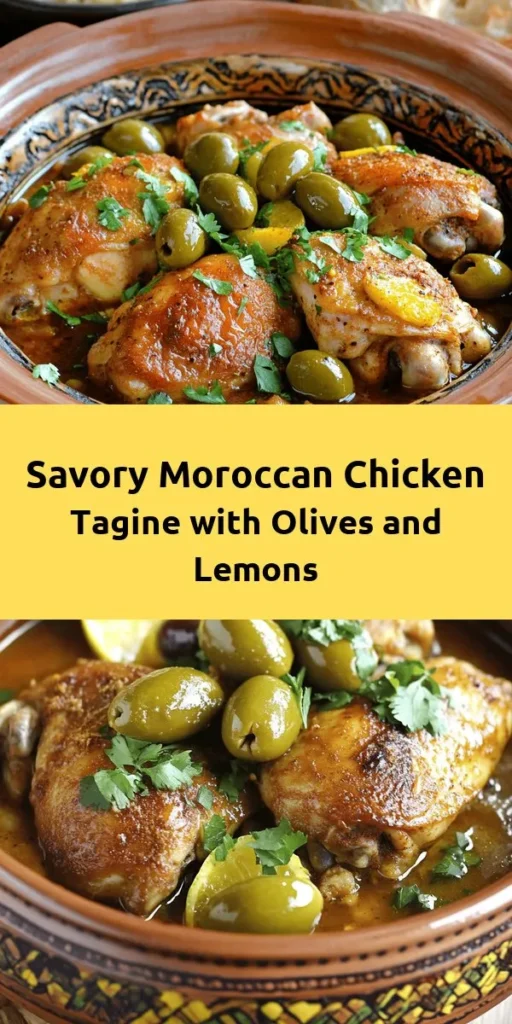Introduction
Moroccan cuisine is a vibrant tapestry woven from a diverse array of flavors, textures, and aromas. With its roots steeped in centuries of trade and cultural exchange, it offers a culinary experience that is as rich as its history. One of the most beloved dishes that exemplifies the essence of Moroccan cooking is the Moroccan Chicken Tagine with Olives and Preserved Lemons. This dish not only showcases the delectable fusion of spices and fresh ingredients but also reflects the communal spirit of Moroccan dining, where meals are often shared among family and friends.
The Moroccan Chicken Tagine is a traditional stew that is cooked slowly in a conical clay pot known as a tagine. This unique cooking method allows the ingredients to simmer gently, melding their flavors while retaining moisture to create tender, succulent chicken. The use of key ingredients like preserved lemons and olives elevates this dish to new heights, offering a balance of tartness and briny depth that is characteristic of Moroccan cuisine.
In this article, you will discover not only the step-by-step process of preparing Moroccan Chicken Tagine but also insights into the cultural significance of the ingredients and cooking methods involved. By the end, you will feel equipped to bring a taste of Morocco into your kitchen, impressing your family and friends with a dish that is as delicious as it is aromatic.
The Essence of Moroccan Cuisine
At the heart of Moroccan cooking lies a distinctive array of spices and ingredients that work in harmony to create memorable flavors. Key spices such as cumin, coriander, ginger, and saffron are often found in Moroccan kitchens, each contributing its own unique character to dishes. The combination of warm spices with fresh herbs like cilantro and parsley creates a vibrant flavor profile that is both comforting and invigorating.
Tagines are not just cooking vessels; they symbolize the essence of Moroccan hospitality. Traditionally, a tagine is used to prepare meals for family gatherings, showcasing the importance of togetherness in Moroccan culture. The conical shape of the tagine allows steam to circulate, ensuring that the food remains moist while allowing the flavors to concentrate. The slow cooking method also encourages the use of tougher cuts of meat, which become tender and flavorful over time.
This cooking technique, combined with the bold flavors of spices and fresh ingredients, makes Moroccan dishes stand out. The Moroccan Chicken Tagine serves as an excellent introduction to this culinary world, as it encapsulates the heartwarming traditions and complex flavors that characterize Moroccan cuisine.
Understanding the Ingredients
To create an authentic Moroccan Chicken Tagine with Olives and Preserved Lemons, it is crucial to use quality ingredients that contribute to the dish’s rich tapestry of flavors. Here’s a closer look at each of the key ingredients that make this dish shine:
Chicken Thighs
For this recipe, bone-in, skin-on chicken thighs are preferred. This choice is crucial as the bones impart additional flavor during the cooking process, while the skin helps to keep the meat moist and tender. Chicken thighs are also more forgiving than chicken breasts, remaining juicy even after extended cooking times, making them ideal for slow-cooked dishes like tagine.
Olive Oil
Olive oil is a staple in Moroccan cooking, known for its rich flavor and health benefits. It serves as the base for sautéing the aromatics and helps to enhance the overall taste of the dish. The use of high-quality extra virgin olive oil is recommended, as it adds depth and a fruity note that complements the spices and chicken beautifully.
Onions and Garlic
Onions and garlic are foundational ingredients in Moroccan cuisine, serving as the aromatic base for many dishes. Onions add sweetness and depth, while garlic provides a pungent kick that enhances the flavor profile of the tagine. Together, they create a fragrant foundation that sets the stage for the spices and other ingredients to shine.
Spices
The spice blend used in Moroccan Chicken Tagine is what truly elevates the dish. Here are the key spices and their contributions:
– Ginger: Offers a warm, zesty flavor that brightens the dish.
– Cumin: Adds an earthy, nutty taste that is essential in Moroccan cooking.
– Cinnamon: Provides warmth and sweetness, balancing the savory notes.
– Turmeric: Gives a vibrant yellow color and a mild, aromatic flavor.
– Cayenne: Introduces a hint of heat, allowing the dish to have a slight kick without being overpowering.
Preserved Lemons
Preserved lemons are a quintessential ingredient in Moroccan cuisine, known for their intense flavor and unique tang. They are made by packing whole lemons in salt and allowing them to ferment, resulting in a soft texture and a concentrated, salty-sour flavor. In the tagine, preserved lemons lend a bright acidity that cuts through the richness of the chicken and adds a distinct Moroccan flair.
Olives
Olives are another signature element in this dish. They provide a briny contrast to the sweet and savory flavors of the tagine. Green olives or Moroccan olives, such as the Castelvetrano variety, are excellent choices, as their buttery flavor complements the other ingredients beautifully. When added at the end of cooking, they maintain their texture and provide a delightful bite.
Chicken Broth
Using chicken broth instead of water adds a layer of richness to the tagine, enhancing the overall flavor. Homemade broth is ideal, but store-bought versions can also work well. The broth helps to create a sauce that can be spooned over the chicken and served with couscous or crusty bread.
Optional Ingredient: Chickpeas
While not essential, adding chickpeas to your Moroccan Chicken Tagine can enhance its heartiness and nutritional value. Chickpeas are a great source of protein and fiber, making the dish more filling. They also absorb the flavors of the tagine, adding their own creamy texture to the mix.
Step-by-Step Guide to Making Moroccan Chicken Tagine
Now that you’ve familiarized yourself with the essential ingredients and their importance, let’s dive into the step-by-step process of creating your very own Moroccan Chicken Tagine. This guide will walk you through each stage, ensuring that you achieve a dish that is bursting with flavor and authenticity.
Step 1: Prepare Your Ingredients
Before you begin cooking, it’s essential to gather and prepare all your ingredients. Start by chopping the onions, mincing the garlic, and cutting the preserved lemons into quarters. If you’re using chickpeas, rinse and drain canned chickpeas or soak dry chickpeas overnight if you’re opting for dried ones.
Step 2: Sear the Chicken
In a large tagine or a heavy-bottomed pot, heat the olive oil over medium-high heat. Season the chicken thighs with salt and pepper, then add them to the pot, skin-side down. Sear the chicken for about 5-7 minutes, or until the skin is golden brown and crispy. Flip the thighs and sear for another 3-4 minutes. Once done, remove the chicken from the pot and set it aside.
Step 3: Sauté the Aromatics
In the same pot, reduce the heat to medium and add the chopped onions. Sauté for about 5 minutes until they begin to soften. Add the minced garlic and cook for an additional minute, stirring frequently to prevent burning. The aroma of the onions and garlic will fill your kitchen, creating a fragrant base for the tagine.
Step 4: Add the Spices
Once the onions and garlic are sautéed, it’s time to add the spices. Sprinkle the ginger, cumin, cinnamon, turmeric, and cayenne into the pot. Stir well to coat the onions and garlic with the spices, allowing them to bloom for about 1-2 minutes. This step is crucial, as it helps to release the essential oils from the spices, enriching the dish’s flavor.
Step 5: Incorporate the Chicken and Broth
Return the seared chicken thighs to the pot, nestling them among the sautéed onions and spices. Pour in the chicken broth, ensuring the chicken is mostly submerged in liquid. Bring the mixture to a gentle simmer, allowing the flavors to meld together.
Step 6: Add Preserved Lemons and Olives
Once the broth is simmering, add the quartered preserved lemons and olives to the pot. These ingredients will impart their signature flavors, enhancing the tagine’s complexity. Stir gently to combine, then cover the pot with its lid.
Step 7: Slow Cook the Tagine
Reduce the heat to low and let the tagine cook for about 45 minutes to an hour. This slow cooking process allows the chicken to become tender and the flavors to develop fully. Check occasionally to ensure that the broth is simmering gently, adding a splash of water or broth if it becomes too dry.
Step 8: Optional – Add Chickpeas
If you’re including chickpeas in your tagine, add them during the last 15 minutes of cooking. Stir to combine, allowing the chickpeas to warm through and absorb the delicious flavors of the dish.
As you approach the end of the cooking time, the aroma of your Moroccan Chicken Tagine will begin to fill your home, inviting everyone to the table for a delightful meal.
By following these steps, you will be well on your way to creating a dish that not only delights the palate but also brings the vibrant essence of Moroccan cuisine into your kitchen. Stay tuned for the next part, where we will explore additional tips for achieving the best results and answer common questions about this beloved dish.

Preparing the Chicken
Before diving into the cooking process, it’s crucial to prepare the chicken properly. Begin by choosing bone-in, skin-on chicken thighs or a whole chicken cut into pieces for the best flavor and tenderness. The first step is to thoroughly pat the chicken dry using paper towels. This step is essential as it helps to achieve a beautiful golden-brown crust during the searing process. Season the chicken generously with salt and pepper to enhance its natural flavors. Allowing the chicken to sit at room temperature for about 30 minutes after seasoning can also help the meat absorb the flavors better.
Searing the Chicken
Once the chicken is prepared, it’s time to sear it. This technique not only adds depth of flavor to the dish but also improves the texture of the chicken. Heat a large, heavy-bottomed tagine or Dutch oven over medium-high heat and add a tablespoon of olive oil. When the oil is shimmering, carefully place the chicken pieces skin-side down in the pot. Avoid overcrowding; work in batches if necessary.
Sear the chicken for about 5-7 minutes, or until the skin is crispy and golden brown. This step is crucial as it creates a rich flavor base for the tagine. Once browned, turn the chicken over and sear the other side for another 5 minutes. After searing, transfer the chicken to a plate and set it aside while you prepare the aromatics.
Sautéing Aromatics
Aromatic vegetables are the backbone of Moroccan Chicken Tagine, infusing the dish with a robust flavor. Using the same pot where you seared the chicken, add diced onions, minced garlic, and grated ginger. Sauté these ingredients over medium heat for about 5 minutes until they are softened and fragrant. The combination of onions, garlic, and ginger creates a flavorful foundation that will complement the spices and the chicken perfectly.
Once the aromatics are sautéed, incorporate diced tomatoes (fresh or canned) into the pot. This addition will provide a natural sweetness and acidity, balancing the richness of the chicken. Stir everything together, scraping the bottom of the pot to lift any delicious brown bits left from searing the chicken.
Spicing It Up
Now comes the magic of Moroccan spices, which are key to achieving the authentic flavor profile of this dish. Add a mix of spices, typically including ground cumin, coriander, cinnamon, turmeric, and a pinch of cayenne pepper for heat. If you have preserved lemons on hand, now is the time to add them, along with the olives. The preserved lemons add a unique tanginess that perfectly complements the spices.
Stir the spices into the mixture and let them toast for about 1-2 minutes. This technique ensures that the spices bloom and release their essential oils, enhancing their flavor. Be sure to taste the mixture at this stage; it should be aromatic and fragrant, setting the stage for the chicken to absorb all these delicious flavors.
Combining Ingredients
With the spices and aromatics well combined, it’s time to introduce the chicken back into the pot. Nestle the seared chicken pieces into the aromatic mixture, ensuring they are surrounded by the flavorful base. Pour in enough chicken broth to cover the chicken halfway. This broth will create a luscious sauce as it simmers and melds with the spices and aromatics.
Gently stir the contents of the pot to combine everything without breaking up the chicken. The goal is to balance the flavors and ensure that every piece of chicken is infused with the rich, aromatic sauce.
Simmering the Tagine
Cover the tagine or pot with a lid and reduce the heat to low. Let the chicken simmer gently for about 45 minutes to 1 hour. This slow cooking method allows the chicken to become tender and juicy, while the flavors meld beautifully. If using a traditional tagine, avoid lifting the lid too often to maintain the steam inside, which helps cook the chicken evenly.
During the last 15 minutes of cooking, check the chicken for tenderness. It should easily pull away from the bone when it’s ready. If the sauce appears too thin, remove the lid and allow it to reduce slightly. Adjust the seasoning with salt and pepper to taste, ensuring the balance of flavors is just right.
Final Touches
As your Moroccan Chicken Tagine nears completion, it’s crucial to taste and adjust the seasoning one final time. The flavors should be vibrant, with the right balance of savory, sweet, tangy, and spicy notes. If desired, you can add a little more preserved lemon or olives to enhance the tanginess. A sprinkle of fresh herbs, such as cilantro or parsley, can also elevate the dish, giving it a fresh finish.
Serving Suggestions
Ideal Accompaniments for Moroccan Chicken Tagine
To create a truly authentic Moroccan dining experience, serve your chicken tagine with traditional accompaniments that complement its flavors.
Fluffy Couscous
Couscous is a classic pairing for tagine dishes. To prepare, use instant couscous for convenience. Boil equal parts water and couscous in a pot, cover, and let it sit for about 5 minutes. Fluff with a fork and drizzle with olive oil or melted butter for added richness. For variations, consider adding herbs, spices, or sautéed vegetables to the couscous for extra flavor.
Crusty Bread
Crusty bread is another excellent accompaniment, perfect for soaking up the delicious sauce. A traditional Moroccan khobz or any rustic bread will work well. Serve it warm, either whole or sliced, allowing diners to tear off pieces to enjoy with the tagine.
Garnishing with Fresh Herbs
Don’t forget to garnish your Moroccan Chicken Tagine with freshly chopped cilantro or parsley before serving. This final touch not only enhances the visual appeal but also adds a burst of freshness that complements the dish beautifully.
Nutritional Insights
Moroccan Chicken Tagine is not only delicious but also packed with nutrition. The key ingredients in this dish provide a variety of health benefits:
– Chicken: A great source of high-quality protein, essential for muscle growth and repair.
– Olives: Rich in monounsaturated fats and antioxidants, olives can benefit heart health.
– Preserved Lemons: High in vitamin C and antioxidants, preserved lemons add flavor and can aid digestion.
– Spices: Ingredients like turmeric and ginger contain anti-inflammatory properties, contributing to overall health.
In one serving of Moroccan Chicken Tagine, you can expect a well-rounded meal with a good balance of protein, healthy fats, and vitamins. This dish provides a satisfying and nourishing option for any dinner table.
Cultural Significance of Tagines
The tagine itself is more than just a cooking vessel; it represents Moroccan culture and traditions. Traditionally, tagines are used in Moroccan households for both cooking and serving meals, often shared among family and friends. This communal style of dining reflects the essence of Moroccan hospitality, where meals are meant to be enjoyed together, fostering connection and conversation.
Moroccan Chicken Tagine, in particular, embodies the spirit of family gatherings. It is often served during special occasions and celebrations, making it a dish that not only nourishes but also brings people together. The aromas wafting from the kitchen and the vibrant colors of the dish create a warm and inviting atmosphere, welcoming all to partake in the meal.
Conclusion
In summary, Moroccan Chicken Tagine with Olives and Preserved Lemons is a dish that offers a unique blend of flavors and a rich cooking experience. The combination of spices, tender chicken, and the tangy brightness of preserved lemons creates a symphony of taste that is both comforting and exotic. We encourage you to delve into Moroccan cuisine and try this recipe at home, discovering the joy of cooking and sharing meals that celebrate cultural traditions.
As you explore the vibrant world of Moroccan dishes, remember that sharing a meal transcends mere nourishment; it’s about creating memories, fostering connections, and appreciating the rich tapestry of culinary history. Enjoy the journey of flavors, and may your kitchen be filled with the warm and inviting scents of Moroccan spices!



